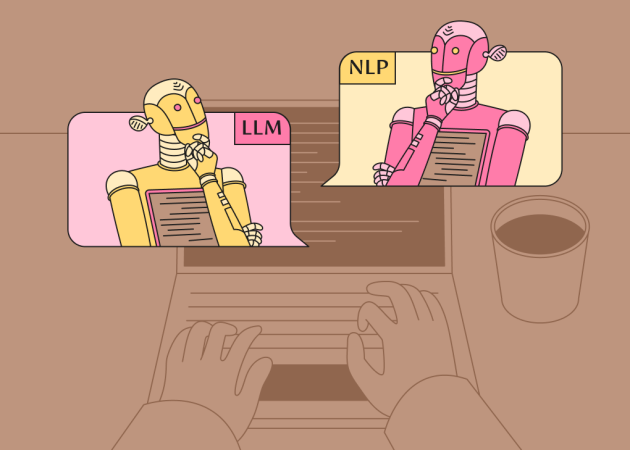
A Tech Lead’s Guide to Interviewing Computer Vision Engineers
Contents
Contents
The global computer vision market is expanding, accelerated by the increasing demand for automation, autonomous vehicles, advancements in AI and machine learning, and progress in hardware and imaging sensors. Grand View Research predicts an impressive growth — from USD 19.82 billion in 2024 to USD 58.3 billion by 2030 at 19.8% CAGR — which only fuels the need for skilled computer vision engineers.
This growth is not just about the numbers; it reflects our digital-driven world, where, according to Statista, the total volume of data is expected to reach 181 zettabytes in 2025. For CTOs and tech leads, this means navigating a landscape rich with opportunities and challenges. That’s where we come in with handy resources.
This article offers a comprehensive guide featuring a range of interview questions on computer vision, tailored to help you assess candidates thoroughly. From machine vision interview questions to those probing the depths of image processing engineering and, importantly, questions that consider cultural and mindset compatibility, we’ve got you covered.
It’s all about connecting the dots between skill, mindset, and the ever-evolving world of computer vision, ensuring you find those gems — technically proficient engineers who are also a great cultural fit for your team.
Unveiling Technical Mastery: Critical Computer Vision Job Interview Questions
Q1. How do you handle overfitting in a deep-learning model for image classification?
Potential Answer: Techniques like data augmentation, dropout layers, early stopping, and adding regularization (e.g., L1/L2 weight decay). Also, batch normalization and simplifying the model architecture. All these help the model generalize better instead of memorizing the training data.
Red Flag: Lacking specific deep-learning strategies (e.g., only mentioning generic ML tactics) or failing to mention any of the standard overfitting remedies would be concerning.
Q2. Explain the concept and application of transfer learning in computer vision.
Potential Answer: Transfer learning means taking a model pre-trained on a large dataset (like ImageNet) and fine-tuning it for a specific task. This approach leverages learned features (edges, shapes, textures) from the large dataset, so it reduces the training time and data requirements for your task significantly while often improving performance.
Red Flag: The inability to explain what transfer learning is or why it’s useful in CV (e.g., saying they’d always train from scratch) would be a red flag.
Q3. Can you explain the concept of feature extraction in computer vision and how it contributes to object detection and recognition?
Potential Answer: Feature extraction involves identifying and extracting important visual patterns (key points, edges, textures, and shapes) from images. Classic techniques include edge detectors (like Sobel/Canny), HOG (Histogram of Oriented Gradients) descriptors, or SIFT keypoints, which pull out defining features of objects. Modern deep learning models (CNNs) do this automatically. These features are crucial because detectors or classifiers use them to recognize objects.
Red Flag: Not being able to describe what features are (e.g., confusing them with raw images) or not connecting features to object detection and recognition.
Q4. In a scenario where you have limited computational resources, how would you approach building an efficient computer vision model without significantly compromising its performance?
Potential Answer: I would focus on efficient architecture and model compression. For instance, choose a lightweight neural network architecture like MobileNet, SqueezeNet, or ShuffleNet. I’d also apply techniques like pruning (removing unneeded neurons/weights) and quantization (running the model with lower precision, e.g., 8-bit integers) to make the model smaller and faster with minimal loss in accuracy.
Another technique is knowledge distillation, where a smaller model is trained to mimic a large model’s predictions, capturing its performance in a compact form. Throughout, I’d be mindful of the trade-off between speed and accuracy, possibly trying multiple approaches to find the best balance.
Red Flag: Proposing overly complex models without regard for computational constraints or not mentioning any techniques to reduce model size/compute. It also signals a lack of awareness of efficient model design.

Q5. Discuss the challenges and solutions when working with imbalanced datasets in a computer vision task.
Potential Answer: An imbalanced dataset can bias a model. AI solutions include collecting more data for under-represented classes if possible and using oversampling or, conversely, under-sampling the majority class. We can also adjust the training process or use specialized loss functions like focal loss to focus the training on hard, minority-class examples. Data augmentation is very useful, too, to balance the training set.
Red Flag: Not acknowledging the imbalance issue or offering no strategy to address it.
Q6. If you were developing a system to detect and classify road signs in different weather conditions, what approach would you take?
Potential Answer: The model needs to be robust to weather variations. I would first ensure robust data collection across diverse conditions. Data augmentation can simulate some of this (adding noise or blurring to mimic rain, adjusting brightness/contrast for glare or night). For more extreme cases, one could even use specialized augmentation techniques or GANs to generate synthetic weather effects on images of road signs.
I’d likely use a convolutional neural network (or an object detection model like YOLO/Faster R-CNN) and train it with weather diversity in mind so it learns to ignore irrelevant features like rain streaks or shadows. During training, I might include normalization steps (for example, histogram equalization) to reduce lighting differences.
The key is continuous testing of the system under different weather scenarios and possibly fine-tuning it for any condition where performance lags.
Red Flag: Overlooking the impact of weather conditions entirely, not mentioning data strategy (just focusing on the model and ignoring the need for diverse training data).
Q7. How would you optimize a facial recognition system to work equally well across diverse ethnic groups?
Potential Answer: I would make fairness a priority from the start. Firstly, ensure the training dataset is truly diverse, with ample representation of different ethnicities, ages, and genders. That reduces the chance the model is biased toward any one group. Next, I’d perform regular bias evaluations, for instance, test the face recognition accuracy separately on subsets of different ethnic groups to see if errors are higher for any group.
If I find bias, I’d address it by augmenting or collecting more data for the under-represented groups (even using synthetic data generation to balance if needed). I might also use techniques like adjusting the decision threshold per group or applying algorithms designed to reduce bias in face recognition. The main point is a conscious, ongoing effort to verify the system performs equally well for everyone.
Red Flag: Ignoring the issue of bias or using the same approach for everyone without any checks. Also, not knowing about the need for diverse data would be a major red flag, as it suggests they might build a system that works great for some people and poorly for others.
Q8. Describe how you would build a model to detect anomalies in X-ray images.
Potential Answer: Anomaly detection in X-rays often means we have far more “normal” examples than anomalies. One possible approach is using an autoencoder or similar unsupervised model trained only on normal X-ray images. The idea is that the model learns to reconstruct normal images well, but if an X-ray with an anomaly (tumor, fracture, etc.) is input, it will reconstruct it poorly, signaling something is off. This way, the system flags unusual images for closer inspection.
If I have labeled anomalies, I could also train a supervised model (e.g., a CNN classifier). But often, in medical imaging, the anomalies are too rare or varied for straightforward supervised learning. I would definitely use transfer learning — perhaps, start with a model pre-trained on general images or a medical image model — and fine-tune it on X-rays to pick up on subtle features.
Throughout development, we need to collaborate with medical experts (radiologists) to validate that the “anomalies” being detected are clinically relevant and to get feedback on false positives/negatives, ensuring the model is actually useful in a medical context.
Red Flag: Underestimating the complexity of medical images (for example, treating it like a standard computer vision task without considering the need for expert validation or the lack of abundant data). Also, failing to mention how they’d handle the scarcity of anomaly examples would be a red flag.
Q9. A client needs a solution to analyze drone footage for agricultural monitoring. What would be your approach?
Potential Answer: I would first clarify what “agricultural monitoring” means for the client: are we detecting crop health, counting plants, spotting pests, or something else? Assuming it’s about crop and field analysis, I’d likely use CNN-based image segmentation or object detection if looking for specific objects (like cattle or farm equipment).
Drone footage implies we might have many frames over time, so if tracking changes is important (growth over time or spread of disease), I could incorporate a temporal element — even a CNN-LSTM setup to analyze sequences of images and detect changes or anomalies over time.
Drone images are high-resolution, so we might split images into tiles or use a model that can handle large images. The imagery can vary in lighting or angle, so I’d apply augmentation (random rotations, brightness shifts) to make the model robust to those. If available, I might integrate domain-specific data like multispectral images or NDVI indices to improve the detection of crop health issues, combining that with the visual analysis for a more accurate solution.
Finally, we need to ensure the solution can run efficiently (possibly on the drone or an edge device for real-time feedback or on a server if high computing is okay) and test it extensively in the field.
Red Flag: Not considering the unique aspects of drone imagery or ignoring the agriculture context. A candidate who suggests something too generic without tailoring to aerial agricultural data might not have the necessary practical sense.
Exploring Values and Cultural Fit
When adding a new computer vision engineer to your team, looking beyond just technical expertise is crucial. This section provides a framework for exploring candidates’ mindsets and values — key elements determining how they’ll tackle technological challenges and integrate with and contribute to your team’s culture.
These questions are designed to uncover insights into their approach to continuous learning, adaptability to change, ethical considerations in technology, problem-solving strategies, and collaborative skills. Finding the right fit is more than just skills; it’s about aligning with your core values and fostering a productive, diverse, and harmonious work environment.
Q10. How would you approach designing a system for automated content moderation in social media images?
Potential Answer: Content moderation is a complex issue that needs a meticulous approach. We can use a multi-label image classification model to detect various types of inappropriate content. The next challenge is handling context — for instance, recognizing that the same image might be acceptable in one context and not in another, which is often hard. One possible solution is a pipeline that checks images for known problem categories (graphic violence, adult content, hate symbols, etc.), possibly leveraging pre-trained models for some categories.
We need to prioritize accuracy and explainability (e.g., using techniques to highlight why an image was flagged) and set up a review process where questionable cases are passed to human moderators.
Red Flag: Overlooking the complexity (for example, thinking a simple classifier with one label “bad content” is enough) or not considering the need for ongoing tuning and ethical oversight and also failing to consider edge cases (like context or the potential for false positives).
Q11. How do you stay updated with the latest computer vision and machine learning advancements, and how do you apply this knowledge in your projects?
Potential Answer: Look for a commitment to continuous learning. The candidate might say they read papers from top conferences (CVPR, ICCV, NeurIPS, etc.) or follow arXiv for new CV research and that they keep up with blogs, newsletters, or communities. Importantly, they should give an example of applying new knowledge. For instance, “I recently learned about a new data augmentation technique from a research paper and applied it to improve a project’s performance.” This shows they don’t just passively consume information; they integrate it into their work.
Red Flag: If someone admits they don’t really stay current or gives a very vague answer (“I Google things sometimes”) — in the fast-evolving CV/ML field, that lack of initiative can be a red flag. Also, if they learn but cannot cite any instance of using new tech/ideas, it might mean they struggle to apply theoretical knowledge practically.

Q12. Can you describe a situation where you had to adapt your approach due to new information or a change in project requirements?
Potential Answer: A strong answer will include a specific example. For instance, the candidate might describe a project where, midway through, the client provided new data or changed the success criteria, forcing them to pivot. They could say something like, “Originally, we planned to use method X, but when we discovered new constraints (such as latency requirements or a different data distribution), I quickly adjusted by exploring an alternative algorithm, and we ended up switching to approach Y to meet the new requirements.”
They should explain how they communicated this with the team and managed the transition. The important part is demonstrating flexibility and problem-solving under changing conditions, as well as learning from the experience.
Red Flag: Resistance to change or an inability to provide any concrete example. If someone cannot recall adjusting to new info, it might suggest they either haven’t worked in dynamic environments, or they didn’t recognize opportunities to adapt.
Q13. In your experience with computer vision projects, how have you ensured that your work aligns with ethical guidelines and societal impacts, especially regarding privacy and bias?
Potential Answer: Expect the candidate to be aware of issues like data privacy, consent, and algorithmic bias. They might talk about using anonymization techniques to protect confidentiality or working with data that’s obtained with proper consent. On the bias side, they should mention being vigilant about bias in datasets and models. Example: evaluating models for bias by testing on different demographic groups and balancing the training data or tweaking the model to mitigate it upon finding imbalance.
They could also mention keeping up with ethical guidelines or frameworks and considering the societal impact of the project (for instance, being cautious about whether the CV system could be used in a way that infringes on privacy). An excellent answer might even reference techniques like differential privacy, federated learning, or model interpretability as tools they’ve used to uphold ethics.
Red Flag: Overlooking ethical considerations, dismissing them because “we just build the tech.” A lack of awareness about bias or privacy in CV (for example, not realizing a facial recognition model could be biased or invade privacy) is a serious red flag in today’s environment.
Q14. Describe a challenging problem you encountered in a computer vision project. How did you approach solving it, and what did you learn from the experience?
Potential Answer: The candidate should recount a real problem and walk through how they solved it. For example, they could have had a project where the object detection model wasn’t accurate enough. Example: facing a challenge where the model’s precision was low in detecting small objects at night.
The engineer could have approached this by systematically analyzing the failure cases and revealing that the dataset had very few nighttime images. A solution could be gathering more data, adjusting the model’s architecture to handle low-light conditions, and iterating until the performance improves.
They should then state what they have learned (e.g., the importance of thorough data diversity and that sometimes a smaller architecture can outperform a larger one and be better suited to the problem). The key is a reflective answer: they identify a specific technical hurdle, outline a problem-solving process, and highlight new knowledge or skills gained from that.
Red Flag: A generic answer without specifics doesn’t demonstrate problem-solving. Also, if they blame others or external factors entirely and don’t convey any personal learning, that’s not a great sign.
Q15. How do you approach collaboration in a team setting, especially when working on complex tasks?
Potential Answer: Look for communication skills, teamwork, and a collaborative approach: breaking complex tasks into sub-tasks and coordinating with team members, participating in code reviews, design discussions, or brainstorming sessions. The answers will reveal if they value open communication, knowledge sharing, and collective problem-solving.
Red Flag: A candidate who implies they prefer to work in isolation on complex projects (“I find it best just to do it myself”) or who struggles to communicate ideas would raise concerns. Complex projects in CV often require interdisciplinary teamwork between data engineers, ML researchers, and domain experts, so an inability or unwillingness to collaborate is a big negative.
Building Your Stellar Computer Vision Team with Beetroot
Building a team that excels in AI/ML and computer vision involves weaving together a tapestry of skills, mindsets, and cultural fits. That’s where we at Beetroot come in with a friendly hand. We’re here to help you navigate these waters with ease and confidence. Our experience piecing together proficient tech teams and helping you future-proof them through tailored workshops and training in emerging technologies means we understand the subtleties of matching the right talent to your unique needs. Whether you’re at the starting line or looking to expand your crew, we’re here to tailor a solution that feels just right for you.
Subscribe to blog updates
Get the best new articles in your inbox. Get the lastest content first.
Recent articles from our magazine
Contact Us
Find out how we can help extend your tech team for sustainable growth.







